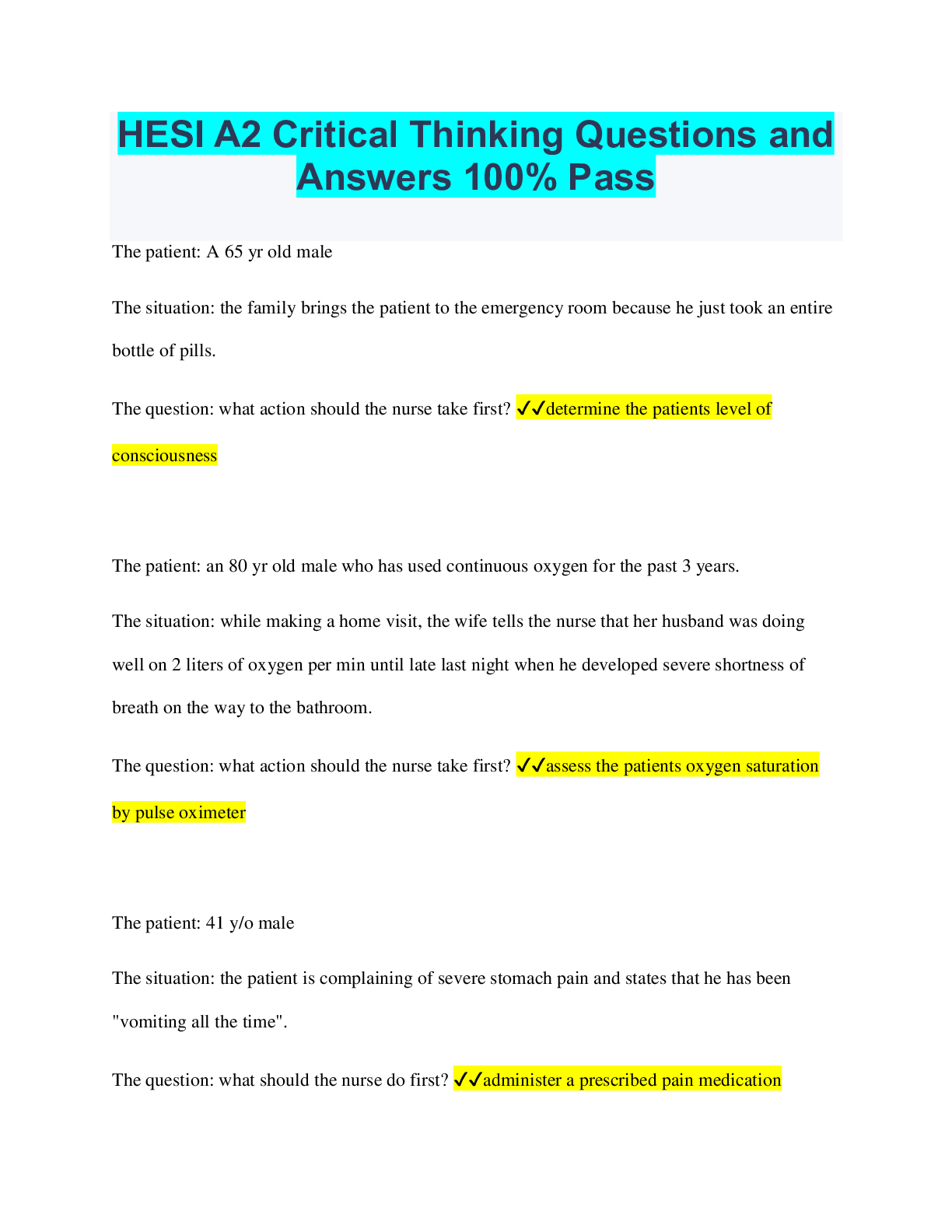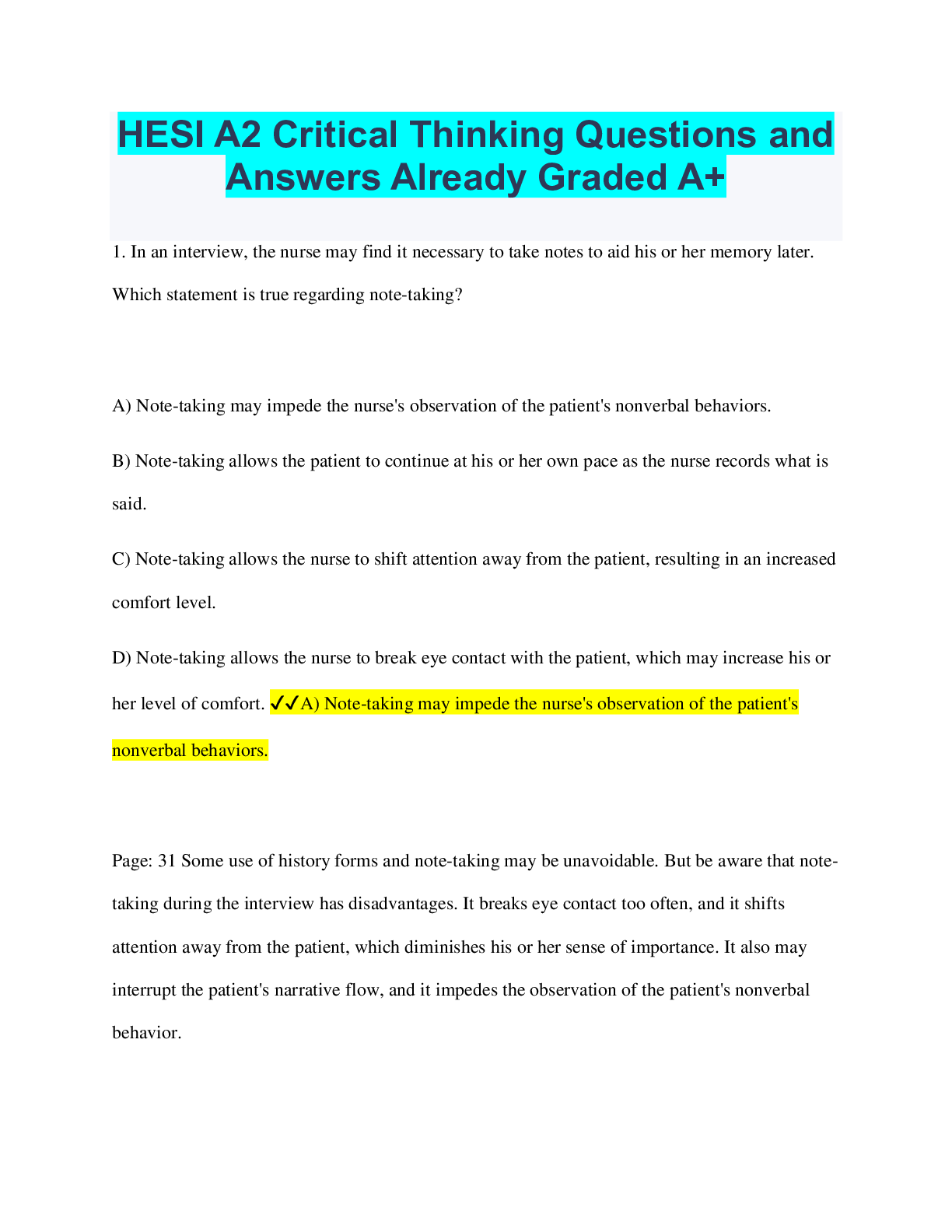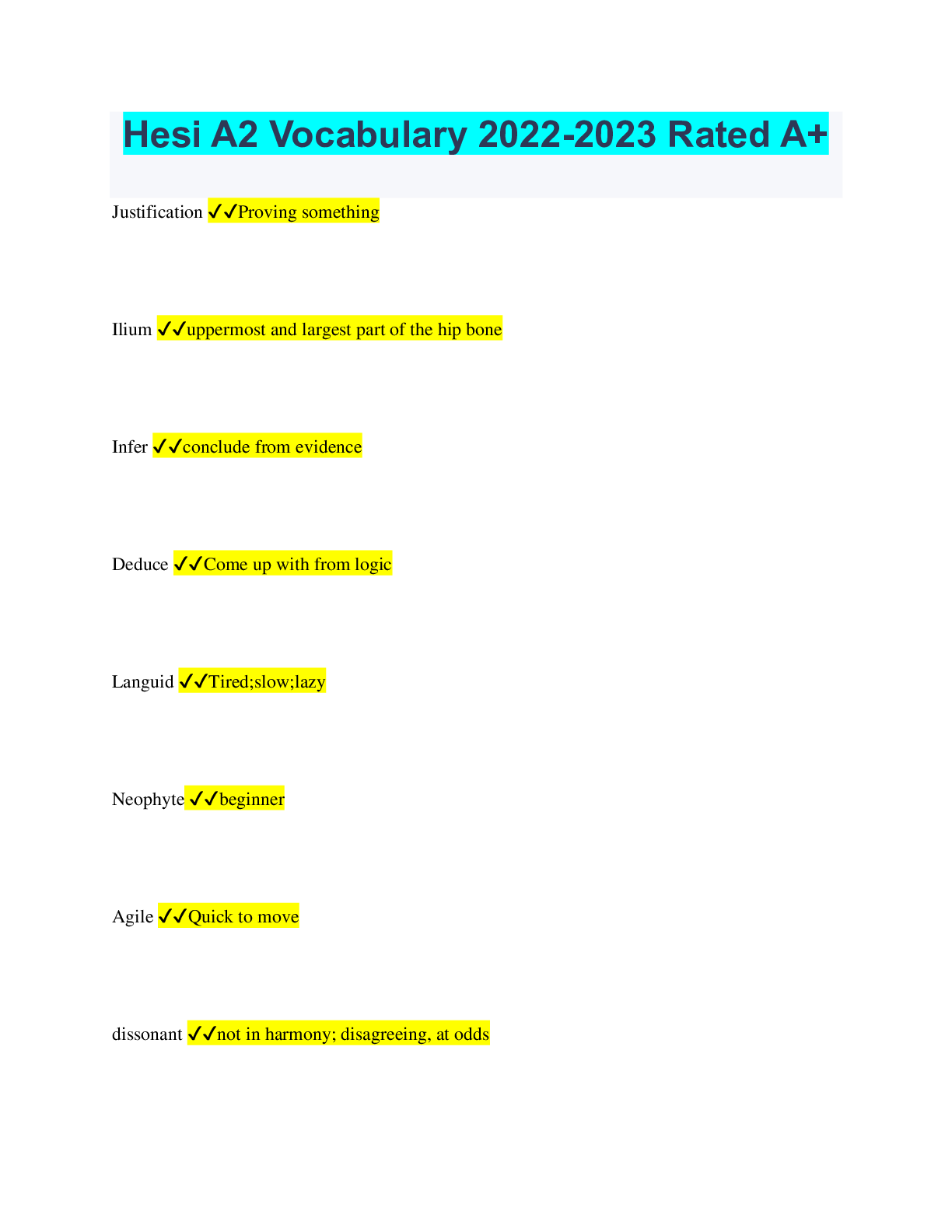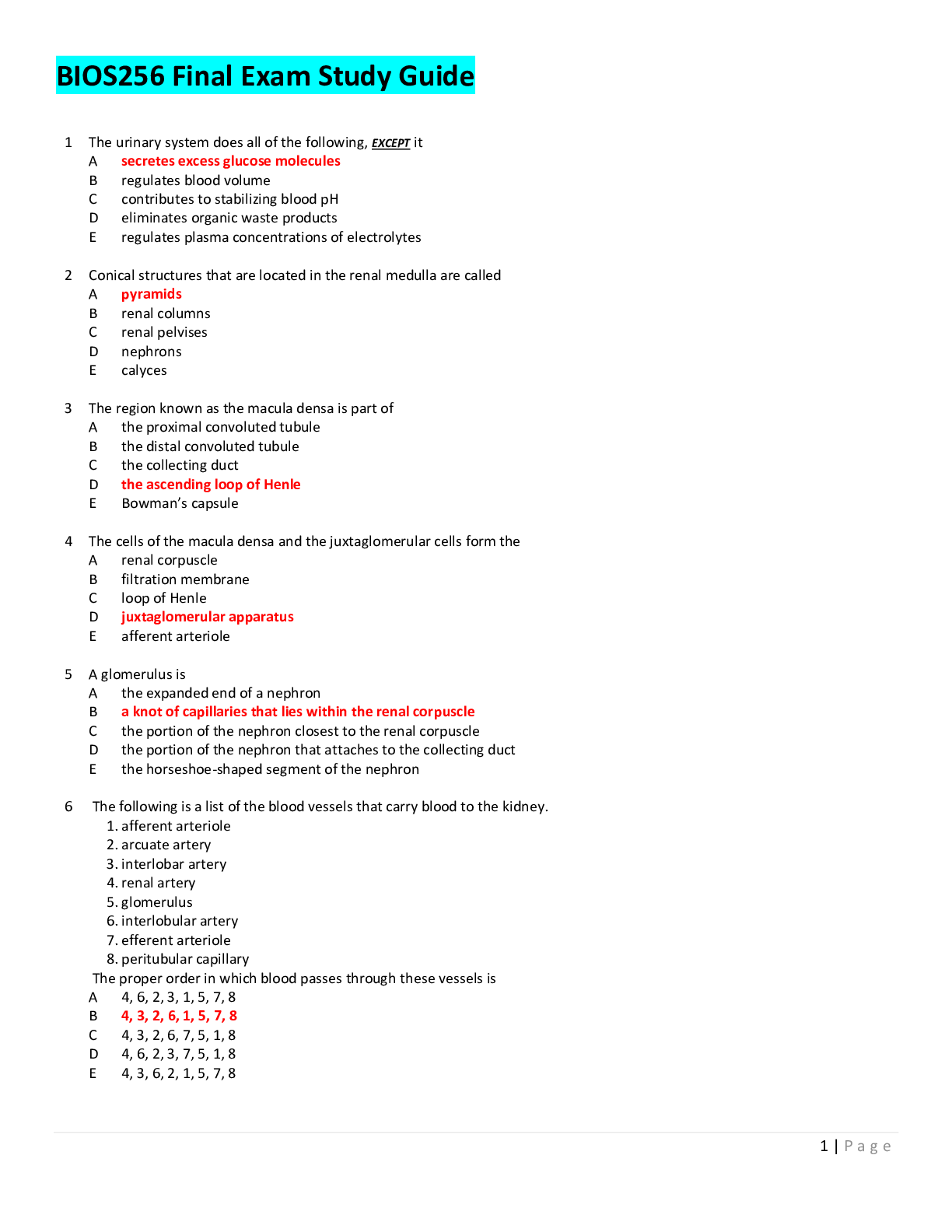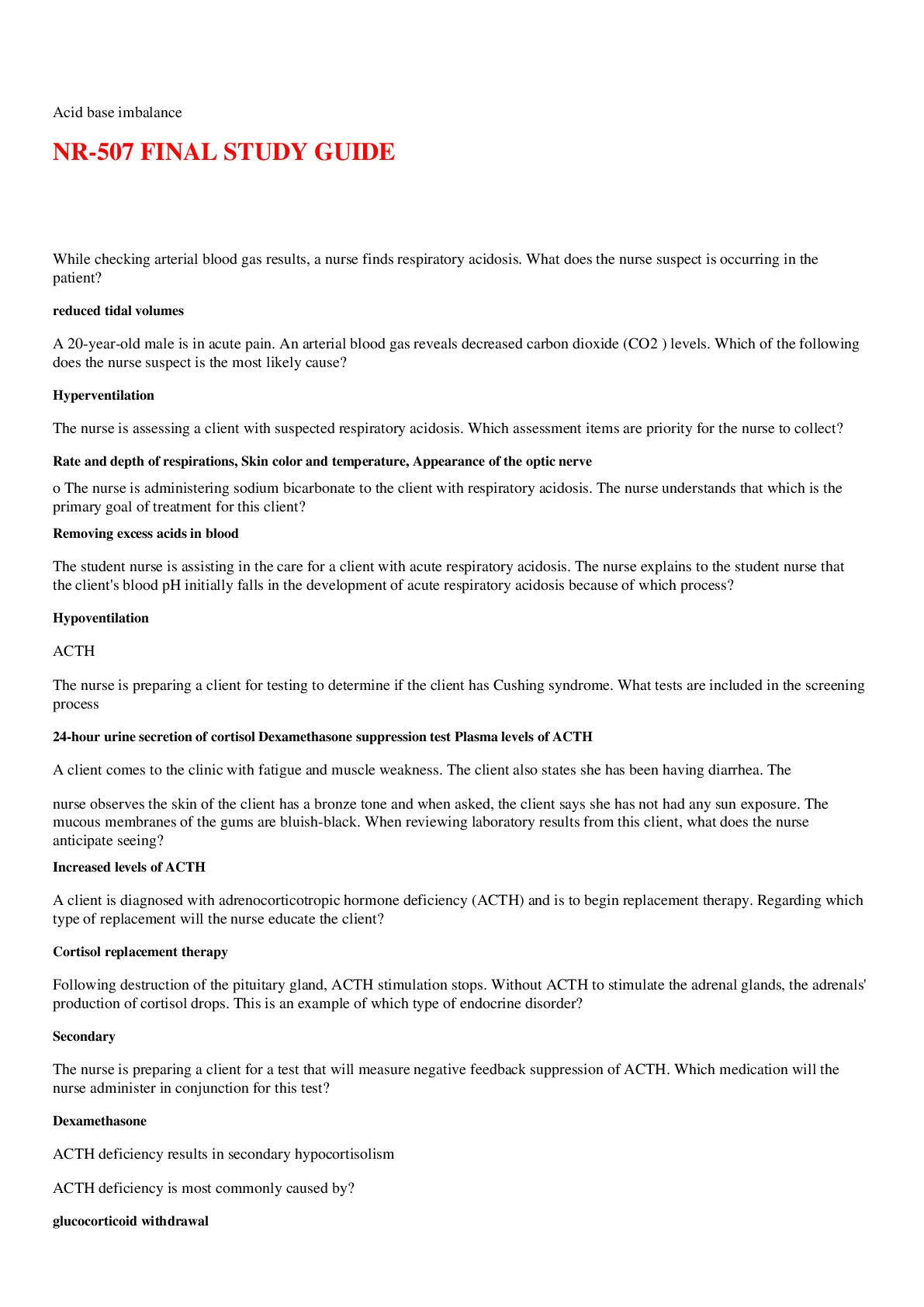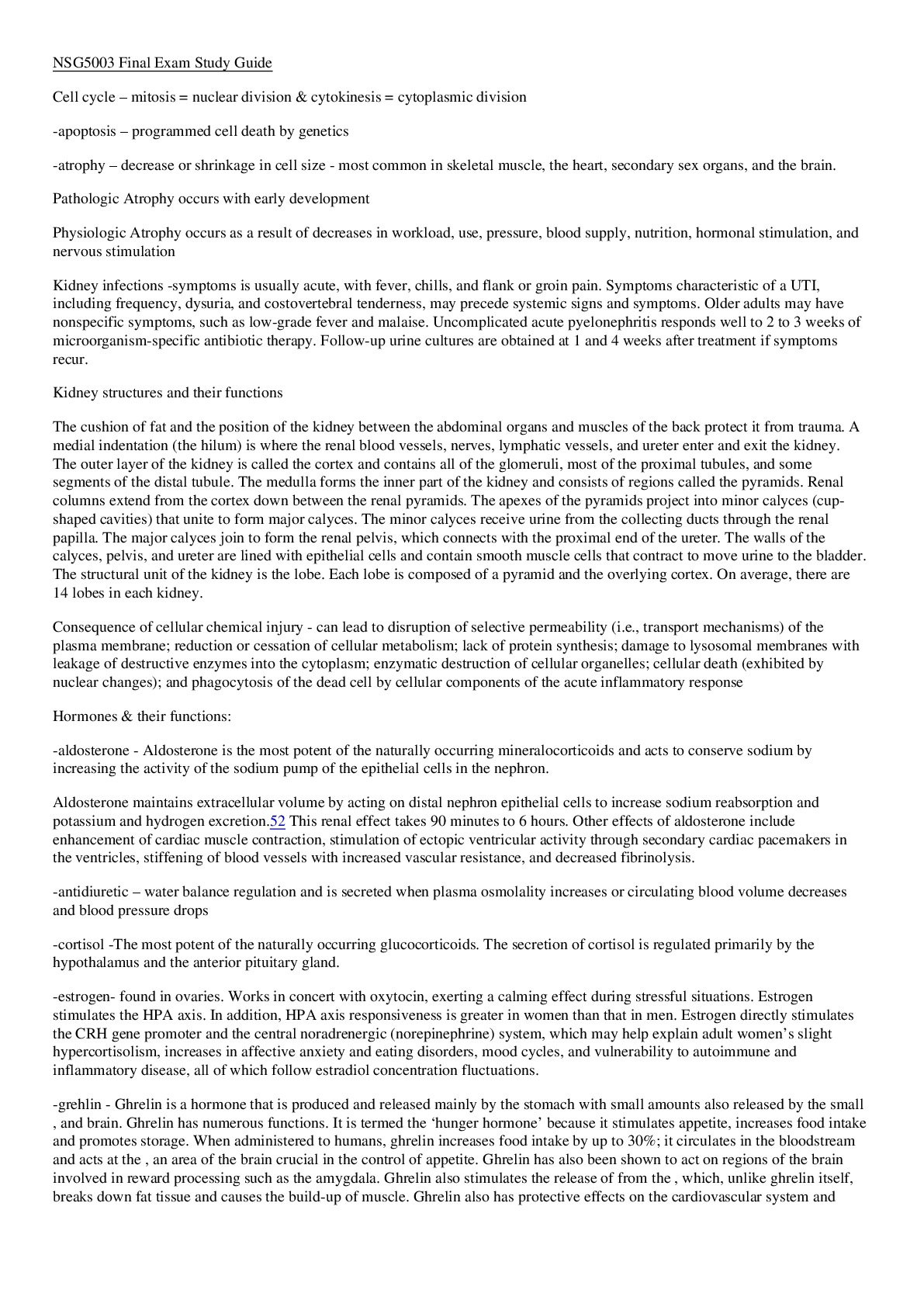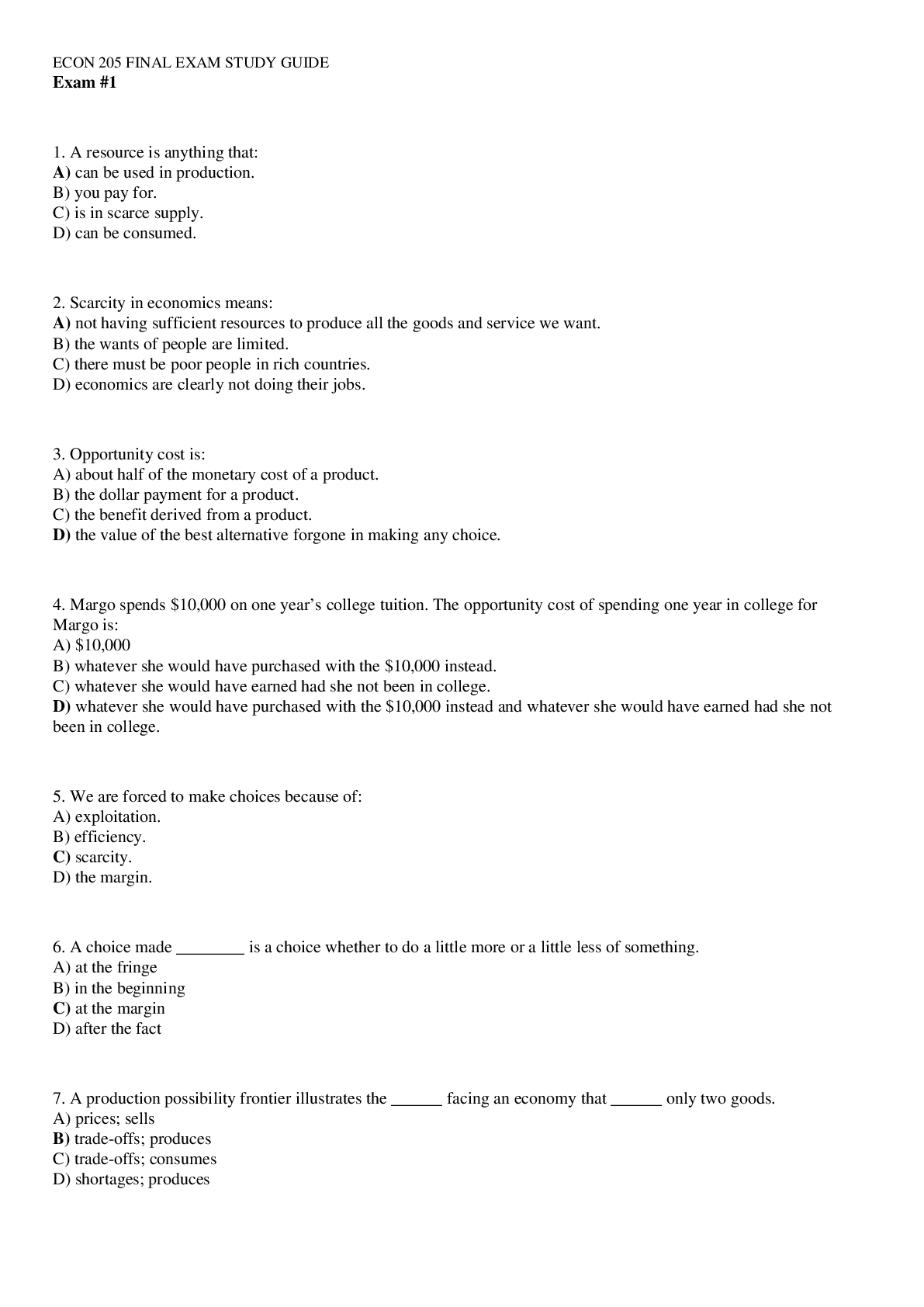Social Sciences > QUESTIONS & ANSWERS > FISDAP Airway Exam Study Guide (2022/2023) Rated A+ (All)
FISDAP Airway Exam Study Guide (2022/2023) Rated A+
Document Content and Description Below
FISDAP Airway Exam Study Guide (2022/2023) Rated A+ Alveolar air volume ✔✔Amount of air that reaches alveoli for gas exchange (approx. 350 ml. For adult male) Tidal volume minus dead space Dea... d air space ✔✔Anatomically: structures that hold air, but can't participate in gas exchange. Physiologically: alveoli or capillaries destroyed by disease Expiratory reserve volume ✔✔Amount of gas that can be forcefully expired at the end of a normal expiration Inspiratory reserve volume ✔✔Amount of gas that can be forcefully inspired in addition to a normal breaths tidal volume Internal respiration ✔✔Exchange of gases between blood cells and tissues Peak expiratory flow ✔✔The greatest rate of airflow during forced expiration when lungs are fully inflated Residual volume ✔✔After maximal forced exhalation, amount of air remaining not able to be expelled Tidal volume ✔✔Amount of air in a respiratory cycle (500 ml, 5-7ml/kg) Minute volume ✔✔Amount of gas moved in and out of respiratory tract per minute Air trapping ✔✔A respiratory pattern associated with an obstruction in the pulmonary tree. Rate increases to overcome resistance Angle of Louis ✔✔Angulation of the sternum that indicates the point where the second rib joins the sternum. (manubriosternal junction) Anoxia ✔✔total lack of oxygen available to the tissues Apnea ✔✔Respiratory arrest Atelectasis ✔✔Abnormal condition characterized by collapse of alveoli, preventing exchange of co2 and o2 in a part of the lungs Barrier device ✔✔Thin film of material placed on the patient's face used to prevent direct contact with the patient's mouth during PPV Carina ✔✔Where the trachea divides into right and left bronchi Ronchi ✔✔Rattling or rumbling in the lungs. Inspiration and expiration. Fluid in larger airways and may be cleared from a cough. Stridor ✔✔Harsh, high-pitched inspiratory sound best heard over the neck Rattles (ronchi) ✔✔Inflammation and mucus or fluid in larger airways heard on inspiration. Associated with bronchitis or pneumonia Crackles (rales) ✔✔Wet lungs - sounds like hair rolled in finger tips. fluid in smaller airways, crackling or popping sound on inspiration, sound that indicates presence of fluid in smaller airways Croup ✔✔Viral infection in upper airway that sounds like a seal bark Wheeze ✔✔Whistling sound heard on inspiration or expiration in pharynx, trachea, bronchi Biots respirations ✔✔Irregular respirations and rate with periods of apnea from increased ICP, brain damage at medulla, DKA, and OD'ing Agonal respirations ✔✔Slow, shallow, irregular from anoxic brain injury Central neurogenic hyperventilation ✔✔Similar to Kussmaul respirations, deep and rapid breathing from increased ICP Cheyne-Stokes respiration ✔✔A pattern of gradually increasing rate and depth of breathing that tapers to slower and shallower breathing with a period of apnea before the cycle repeats Hering-Breuer reflex ✔✔Reflex that limits inspiration and prevents overinflation Hiccup ✔✔Spasm of the diaphragm Benign tumor ✔✔Not spreading aggressively Malignant tumor ✔✔Aggressively spreads Secondary tumor ✔✔Spread from its original location Primary tumor ✔✔Collection of cells that grow out of control, in excess of normal rate. Tumor that develops in only 1 tissue Acute Respiratory Distress syndrome (ARDS) ✔✔Collection of fluid in the alveoli of the lung, usually from trauma or illness Compliance ✔✔Resistance of the patient's lung tissue to ventilation Bilevel Positive Airway Pressure Device (BiPAP) ✔✔Air pressure during inhalation and lower pressure to during exhalation Continuous Positive Airway Pressure (CPAP) ✔✔Slight PPV throughout the respiratory cycle to prevent airway collapse Costal angle ✔✔Angle formed by the margins of the ribs and the sternum Coughing ✔✔Protective mechanism from mucosal irritation. Can clear bronchioles and bronchi Crepitation ✔✔Crackling sound from bones grinding Cricothyroid membrane ✔✔Fibrous membrane between cricoid and thyroid cartilage Cricothyrotomy ✔✔Emergency entrance into the airway Dyspnea ✔✔Uncomfortable awareness of one's breathing Functional reserve capacity ✔✔At end of normal expiration, the volume of air remaining in lungs External respiration ✔✔Exchange of gases between alveoli and pulmonary capillaries Fraction of Inspired Oxygen (FiO2) ✔✔The percentage of oxygen in inspired air. This percentage increases with supplemental oxygen. This value is commonly given as a decimal (Ex: room air is 21% O2, so FiO2 = 0.21). Gagging ✔✔Brooks on a friday night Gag reflex ✔✔Something brooks is working on getting rid of. Glottis ✔✔True vocal cords and space between them Hemoglobin ✔✔A protein Hilum ✔✔Point of entry for bronchial vessels, bronchi, and nerves in lung Hypoxemia ✔✔Deficiency in the concentration of oxygen in arterial blood. Hypoxia ✔✔Inadequate oxygenation of the cells Orthopnea ✔✔Dyspnea relieved by a change in position, SLEEPING UPRIGHT with pillows, usually CHF pulmonary edema problem. Oxyhemoglobin ✔✔Hemoglobin with oxygen bound to it Partial pressure ✔✔Pressure exerted by an individual gas in a mixture Positive End-Expiratory Pressure (PEEP) ✔✔Amount of pressure above atmospheric pressure present in the airway at the end of the expiratory cycle Respiration ✔✔Exchange of gas Saturation of peripheral oxygen ✔✔SpO2 Sellick maneuver ✔✔Technique used to compress the cricoid against the cervical vertebrae, occluding the esophagus Surfactant ✔✔Specialized cells that keep alveoli from collapsing Tracheal stoma ✔✔Surgical opening in neck Tracheostomy ✔✔Surgical creation of a hole in the anterior trachea for breathing Uvula ✔✔Fleshy tissue resembling a grape that hangs down from soft palate Vallecula ✔✔Depression or pocket between the base of the tongue and the epiglottis Ventilation ✔✔Mechanical process of moving air Alveoli ✔✔Functional units of the respiratory system. Area in the lungs where the majority of the gas exchange takes place Aspiration pneumonitis ✔✔Inflammation of the bronchi and alveoli caused by inhaled foreign objects. Bacterial tracheitis ✔✔Potentially serious bacterial infection of trachea Barotrauma ✔✔Injury that results from rapid or extreme changes in pressure Bronchiolitis ✔✔Acute infectious inflammatory disease of the upper and lower respiratory tracts that results in obstruction of the small airways Bronchitis ✔✔Inflammation of the lower respiratory tract Bronchopulmonary dysplasia ✔✔Respiratory condition in infants usually arising from preterm birth Carbon Dioxide narcosis ✔✔Mostly seen in COPD where CO2 is excessively retained causing ALOC Carpopedal spasm ✔✔Cramping of extremities from hyperventilation Circumoral paresthesia ✔✔A feeling of tingling around lips Collapsed lung ✔✔Brooks sucks Costochondritis ✔✔Inflammation of the cartilage in the anterior chest that is painful Cystic Fibrosis (CF) ✔✔Genetic disease marked by hyper-secretion of glands, including mucous in lungs Emphysema ✔✔Destruction of the alveoli Esophagoduodenoscopy ✔✔Endoscope is used to look at the esophagus, stomach, and duodenum Hamman's sign ✔✔Crunching sounds occasionally heard on the heart when air is in mediastinum Mainstem bronchi ✔✔Each of two main breathing tubes off the trachea Mediastinitis ✔✔Infection in the mediastinum Mediastinoscopy ✔✔Surgical procedure of looking into mediastinum with an endoscope NCPE (Non-Cardiogenic Pulmonary Edema) ✔✔Fluid collection in the alveoli of the lung that does not result from heart failure Ostomy ✔✔A hole, usually referring to a surgically made hole. Pallor ✔✔Pale washed out coloration of skin Peak flow meter ✔✔Device used to assess severity of respiratory distress Pleural effusion ✔✔Fluid in the pleural space, usually fluid that seeped from lung or chest wall Pleurisy ✔✔Painful rubbing of pleural lining Pneumomediastinum ✔✔Air entrapped within the mediastinum. Pneumonia ✔✔Infection in lungs Pulmonary abscess ✔✔Collection of pus within the lung Pulmonary bleb ✔✔Cavity in the lung much like a balloon Pulmonary Embolism (PE) ✔✔Clot lodged in pulmonary artery Respiratory failure ✔✔Inadequate blood oxygenation and or ventilation to meet the metabolic demands of body tissue Retractions ✔✔Use of accessory muscles Supraglottic ✔✔Airway structure above vocal chords Synchronized Intermittent Mandatory Ventilation (SIMV) ✔✔Vent setting that generally allows the patient to inspire at will and to the depth that he or she desires Tuberculosis (TB) ✔✔Highly contagious bacterial infection known for causing pneumonia and infecting other parts of the body Peritonsillar abscess (PTA) ✔✔Infection of tissue between the tonsil and pharynx Respiratory Syncytial Virus (RSV) ✔✔A virus linked to bronchiolitis in infants and children Methicillin Resistant Staphylococcus Aureus (MRSA) ✔✔Any of several bacterial strains of S. aureus resistant to methicillin (a penicillin) and related drugs Upper Respiratory Infection (URI) ✔✔Viral syndrome causing nasal congestion and fever Vancomycin Resistant Enterococcus (VRE) ✔✔Bacteria resistant to vancomycin [Show More]
Last updated: 1 year ago
Preview 1 out of 14 pages

Buy this document to get the full access instantly
Instant Download Access after purchase
Buy NowInstant download
We Accept:

Reviews( 0 )
$10.00
Can't find what you want? Try our AI powered Search
Document information
Connected school, study & course
About the document
Uploaded On
Jul 16, 2023
Number of pages
14
Written in
Additional information
This document has been written for:
Uploaded
Jul 16, 2023
Downloads
0
Views
163










